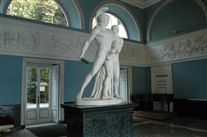4d4185550aae9.jpg
Villa Carlotta Marble Room - Click 'Details' for more information
MARBLE ROOM:
This room has an extraordinary carinate vault painted in coffers, stars and rosettes in fake stuccowork. Under this vault, along the perimeter is located one of the masterpieces of the collection: the high relief with the Entrance of Alexander the Great in Babylonia by the Danish sculptor Bertel Thorvaldsen (1768-1844). This work was brought about in a first version in stucco for the Quirinale Palace in Rome on the occasion of Napoleon's visit. Completed in June 1812, it was so beautiful that Napoleon ordered a marble replica for the Pantheon in Paris. The changed political conditions arrested the very expensive order, till Gian Battista Sommariva decided to relieve it in 1818. The 33 marble slabs of the frieze arrived in the villa in Tremezzo between 1818 and 1828 composing year after year the scene of the triumphal entering of Alexander the Great and his army in Babylonia. Alexander is on a quadriga, guided by a winged Victory; he is followed by two squires with weapons, the impetuous horse Bucephalus, his cavalry and his infantry, an elephant with the spoils of war and a slave king. The last two character at the end of the frieze are a self portrait of Thorvaldsen and a portrait of Sommariva. On the other side of the frieze Peace is guiding the Babylonia citizens: the satrap Mazzeo with his sons, priests and dancers, soothsayers and musicians, fishermen and shepherds.
At the centre of the room is located the monumental group of Venus and Mars, a work by Luigi Acquisti. This statue was commissioned by Sommariva with the explicit aim to celebrate, with such monumental and allegorical representation, the peace brought in Europe by the Napoleonic government. What makes this work unique is the perfect balance between two extremes: the fierce Mars and the sweet Venus. This sculpture, originally located directly on the floor, was in 1822 raised on a precious monolithic block of Varenna marble.
